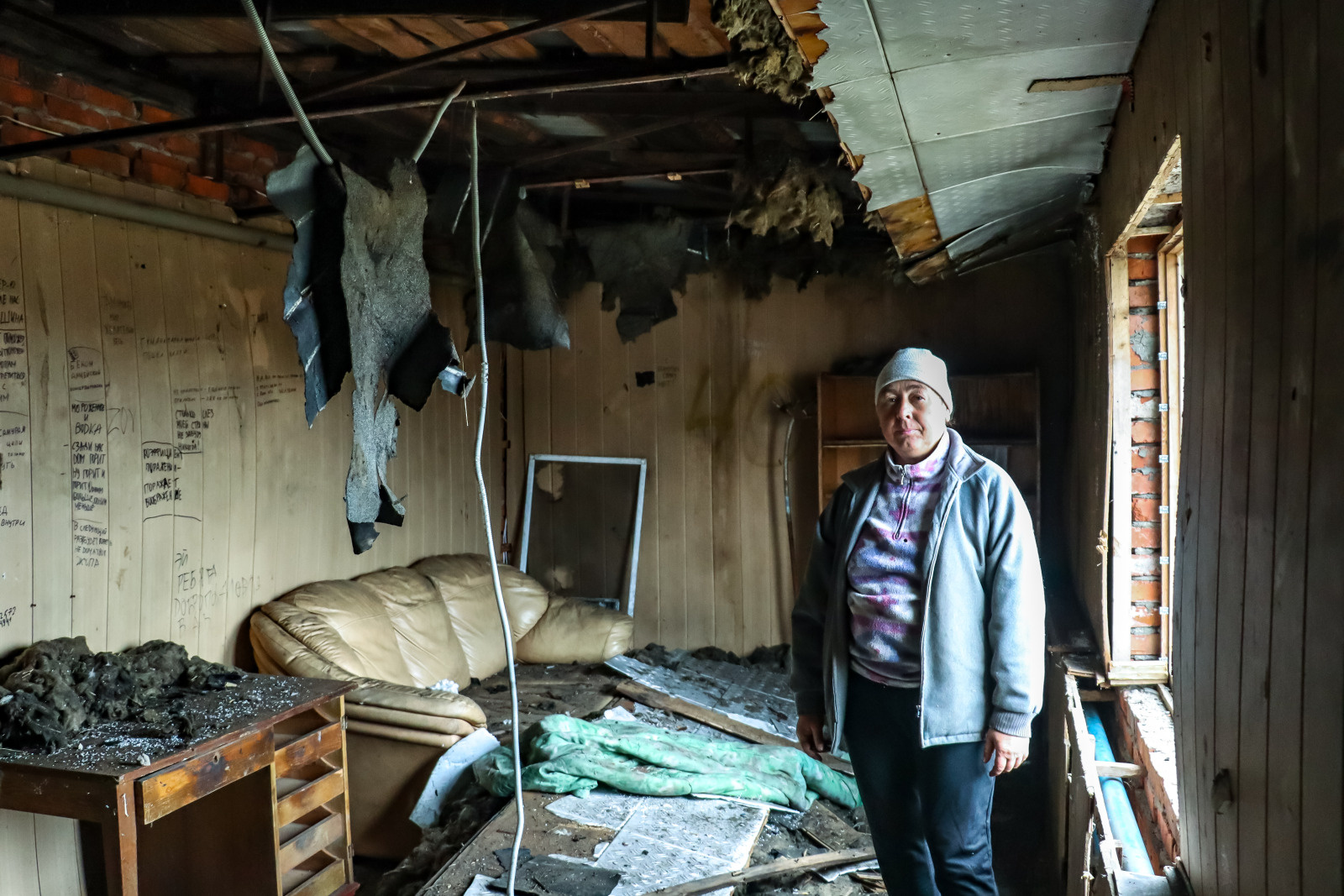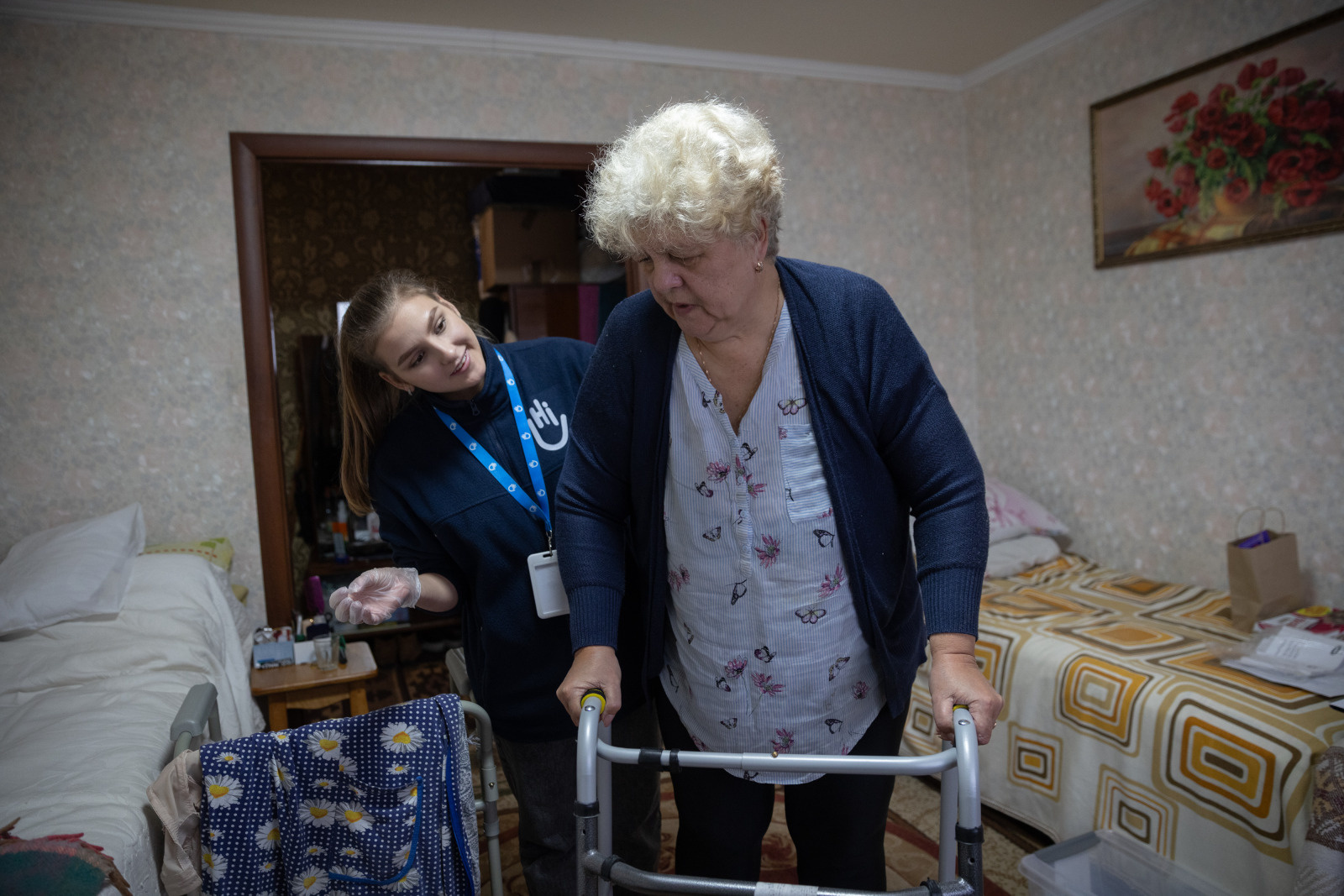In Ukraine, explosive weapons have made towns and villages isolated and inaccessible
February 8, 2024

Nazar, 11, participated in a risk education session organized by HI in Velyka Komyshuvakha, Kharkiv region. | © M.Monier / HI
February 8, 2024

Nazar, 11, participated in a risk education session organized by HI in Velyka Komyshuvakha, Kharkiv region. | © M.Monier / HI
Silver Spring, Maryland — Two years after the escalation of the conflict in Ukraine, an estimated 25% of the country has been exposed to intense fighting, according to the UN Office for the Coordination of Humanitarian Affairs (OCHA). By destroying essential infrastructure such as roads, hospitals and schools, the massive use of explosive weapons has isolated certain areas and their communities from the rest of the world, exacerbating humanitarian needs.
In Ukraine, the use of explosive weapons has both direct (reduced access to essential services such as health, livelihoods, etc.) and indirect consequences (education, mental health, social ties, etc.) for civilian populations, especially older people, children and people with disabilities.
In some areas, such as Kharkiv and Dnipro in the east, and Mykolaiv and Kherson in the south of the country, the frequency of bombings and the extent of the contamination by explosive remnants of war have cut some communities off from the rest of the world.
In areas under constant attack, residents have no electricity, gas or water, and are dependent on generators for limited mobile data and internet access. Food and non-food items are also in limited supply. Where communities are accessible, the main needs are for fuel and generators to power water pumps, which continue to be affected by the bombing and power surges.
The needs are particularly acute in small rural towns and villages, far from medical facilities, dependent on transport systems, and where resources are often centralized in a single shop, grocery store or post office.

Inna, aged 53, from Valyka Komyshuvakha, Ukraine. ©M. Monier / HI
“The only cafe we had is in ruins. We don't have a shop here; there’s nothing left. For medical care, we have to take the car and drive at least 25 kilometers (15 miles). Otherwise, a doctor comes to the village once a week. Who cares about us?” —Inna from Kharkiv
Inna used to be a farmer. She lives in Velyka Komishuvakha, a farming village in the Kharkiv region. From April to September 2022, the village was occupied by Russian forces. According to the authorities, it is now 90% destroyed.
The large-scale contamination of land by explosive ordnance has also created an “invisible threat” in people’s minds. As a result, people’s movements are extremely reduced or restricted, they can no longer cultivate their land and their social, economic, or professional activities are interrupted.
Before the conflict escalated, there were almost 3 million people with disabilities in Ukraine. A quarter of the population is over 60, and more than 80% of single pensioners, the majority of whom are women, are living below the poverty line.
In populated areas close to the front line, most of the inhabitants have been evacuated or have fled the fighting. But not everyone has been able to leave and seek refuge elsewhere. In fact, according to the testimonies gathered by HI, a large majority of older people, including a high proportion of people with disabilities, have remained despite the relentless airstrikes, either because they were reluctant to leave or because they were unable to do so.
"People most at risk disproportionately remain in areas highly impacted by the conflict, either because they are reluctant to or are unable to leave. Isolation, constant shelling and a lack of essential care have mental health and psychosocial impacts and will affect communities most at risk and their caregivers for years to come." —Anna-Marie Robertson, HI Ukraine Advocacy Officer
After two years of hostilities, access to healthcare is one of the biggest humanitarian needs encountered by HI’s teams in Ukraine.
"Reduced access to such basic needs as medical care has serious consequences: a general deterioration in people's health and the worsening of chronic illnesses or the appearance of new ones. Exposure to chronic stress in a war situation can also affect people's health, weakening them both psychologically and physically." —Irina Yashchuk, head of HI's health project in the East of Ukraine.

At present, 14.6 million people need humanitarian aid, including almost 4 million internally displaced people, 4.4 million returnees and 6.9 million people who have stayed at home throughout the war.
For the past two years, HI has been working in Ukraine to assist all victims of the war. The teams have put a multi-sectoral response in place, including rehabilitation and psychosocial support, explosive ordnance risk education (EORE), delivering humanitarian goods to conflict-affected populations, providing essential hygiene items and cash to meet the most urgent needs of displaced people, while advocating for an inclusive humanitarian response.
Some activities, such as healthcare, the delivery of humanitarian aid and explosive ordnance risk education are crucial in hard-to-reach areas, and HI is adapting its activities to these contexts.
Teams are currently providing rehabilitation and psychosocial support to nine Ukrainian hospitals, most of them close to the front line in the Kharkiv and Dnipro regions, where there are many war-wounded. Mobile teams also go to centers for internally displaced people and do home visits to provide rehabilitation services to vulnerable people who can’t reach health facilities.
To ensure humanitarian aid is delivered to the most isolated areas, HI’s logistics unit, Atlas Logistique, stores and transports humanitarian goods on behalf of other NGOs, currently covering 23 oblasts in eastern and southern Ukraine.
Finally, raising community awareness of the dangers of explosive remnants of war is essential, all the more so in isolated areas where "risky" behavior is very common. HI is therefore providing Conflict Preparedness and Protection and Explosive Ordnance Risk Education sessions to enable children, adults and humanitarian workers to spot the danger signs in areas contaminated by explosive ordnance and to protect themselves by adopting safe behavior. Some sessions are held virtually when security issues prevent access to the communities.
"I used to be a deminer and I can tell you that it will take decades to clear the contamination here. As time goes by, people in the big cities are more and more aware of the risks. But it's important to keep going to these isolated villages to inform people of the dangers. These are areas no one wants to go to because they're too hard to reach. So the people there are less aware of the risks. I want to save as many lives as possible.” —Victoria Vdovichuk, HI's Risk Education team leader in Kharkiv region.
Please direct media inquiries to Elizabeth Johnson Sellers at [email protected] or 270-847-3443.
Since the start of HI’s emergency intervention in 2022, HI's activities in Ukraine include:
Co-winner of the Nobel Peace Prize, Humanity & Inclusion (HI) works in situations of poverty and exclusion, conflict and disaster. We work tirelessly alongside people with disabilities and individuals experiencing hardship to help meet their basic needs, improve their living conditions and promote respect for their dignity and fundamental rights. For more than 40 years, HI has been campaigning against anti-personnel mines and cluster bombs, with projects ranging from bomb clearance, risk education teaching civilians about the dangers of these weapons and victim assistance.
Humanity & Inclusion has been one of the leading civil society organizations in the process that has led to the recent signing of the Political Declaration on Explosive Weapons in Populated Areas (EWIPA), adopted in November 2022. As part of the International Network on Explosive Weapons (INEW), HI aims to continue monitoring the humanitarian impact of the use of EWIPA, the implementation of the Political Declaration and to hold States accountable to their commitments.
MEDIA CONTACT
Elizabeth Johnson Sellers,
Communications Director
Email: e[email protected]
Phone: +1 (240) 450-3538
Get the latest news about Humanity & Inclusion's work delivered straight to your inbox.
ABOUT US
Humanity & Inclusion U.S.
8757 Georgia Avenue
Suite 420
Silver Spring, MD 20910
MORE INFORMATION
Humanity & Inclusion is a nonprofit 501(c)(3) organization (EIN/tax ID number: 55-0914744). Contributions are fully tax-deductible to the extent allowable by law. CFC #51472
None of the funds donated through this website will benefit activities in the following countries: Cuba, Iran, North Korea, the Crimea Region, or Syria. Humanity & Inclusion does not have programs in all of these countries.